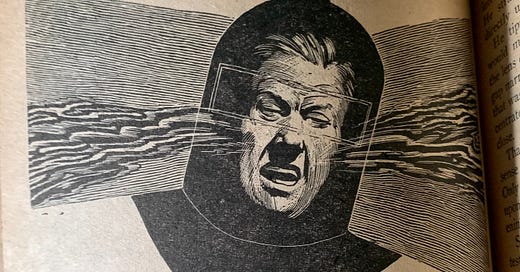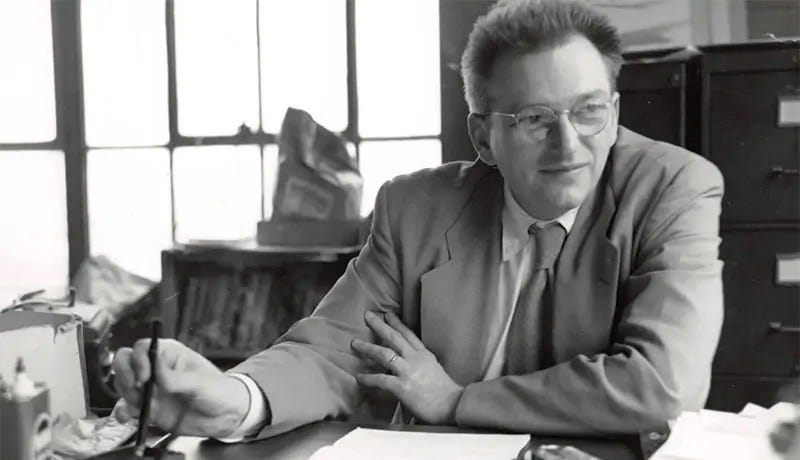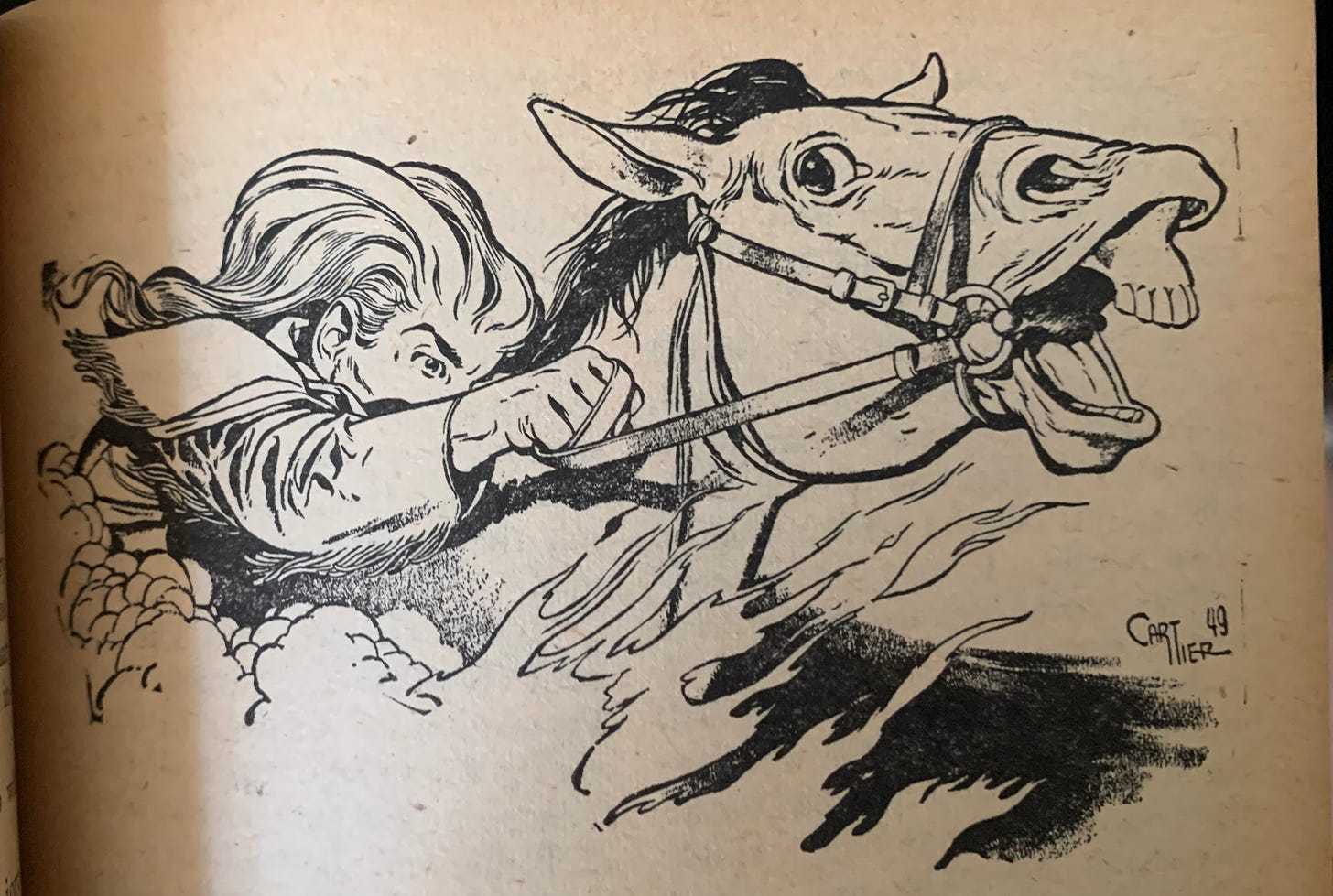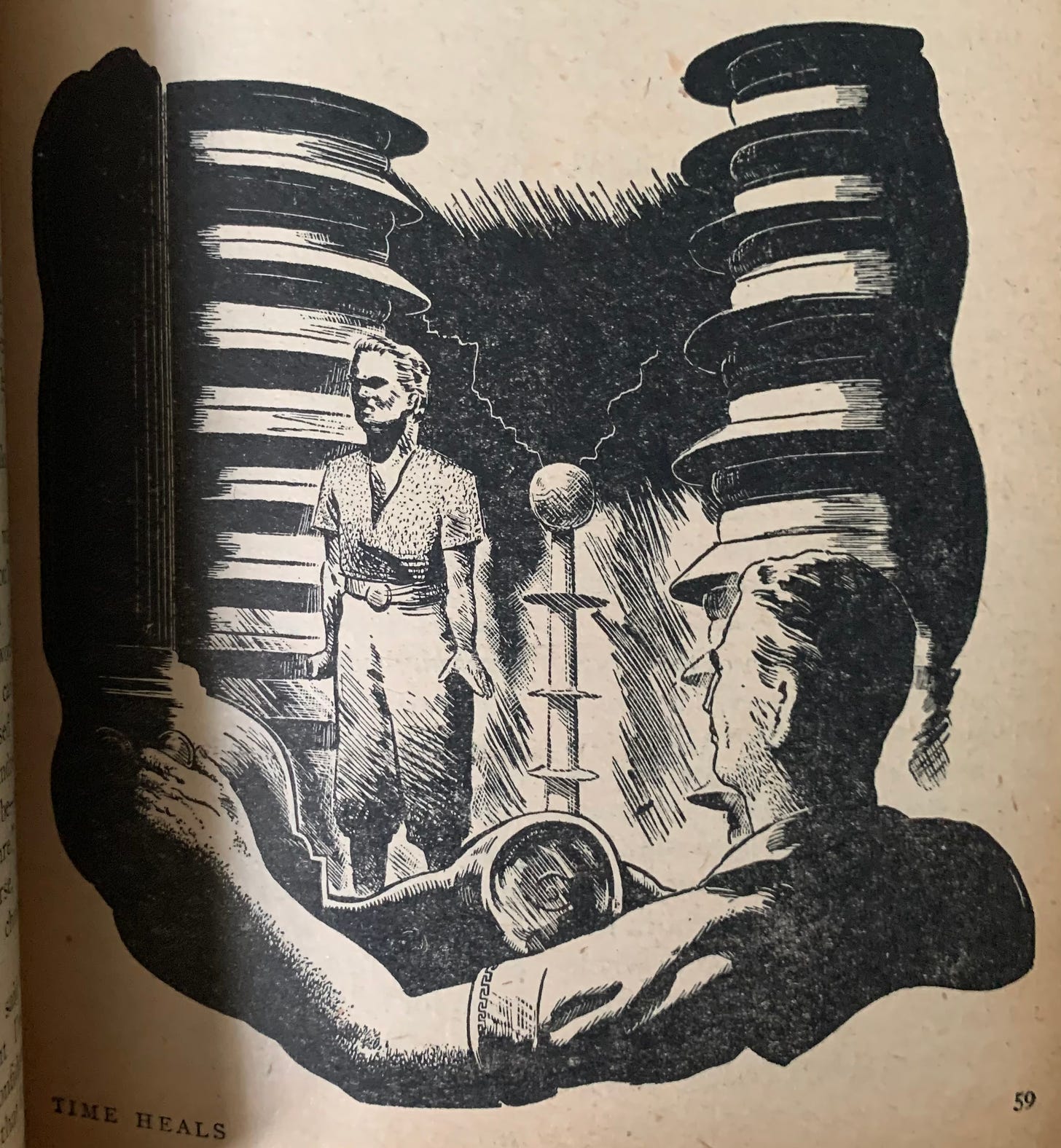Astounding Science Fiction, Oct. 1949
An Apologia For John W. Campbell. Reviews Of Fiction By L. Ron Hubbard, Poul Anderson, Katherine MacLean And Others.
Greetings and Salutations! This installment of the Official William Emmons Books Newsletter is a look at the October 1949 issue of Astounding Science Fiction. I’ll be getting into the meat of the issue in this post. But since this is the first full issue of Astounding I’ve reviewed here, I’ll start by laying down some background on where this issue fits into the long life of Astounding. I also find it topical to make an apologia for its controversial and influential editor John W. Campbell before diving in. I’m pleased to get this installment of the newsletter out on a Sunday because it is kind of a long read.
On Background
In June, I’ve managed to read whole issues of each of the big three science fiction magazines of the 1950s. I’ve already done a post comparing what I’ve read in Galaxy to what I’ve read in F&SF. Those two were upstarts that changed the face of science fiction but perhaps I ought to have started by looking at what they were reacting to, i.e., Astounding, the magazine that revolutionized and defined what science fiction was in the 1940s. Indeed, in a response to my Galaxy vs. F&SF post, one Facebook commenter noted Galaxy’s raison d’être was to create a magazine like Astounding without Campbell’s quirks.
The question was where to start in on Astounding. The magazine debuted in late 1929. The early stuff published by Clayton is ghastly. It was acquired by Street & Smith in 1934 and starts to become interesting to my current line of investigation in 1937 when Campbell was brought in as editor.
Campbell’s editorial career really kicked into gear with the July 1939 issue which featured important stories by A. E. Van Vogt and Isaac Asimov. This inaugurated the so-called Golden Age of Science Fiction which was not only limited solely to Astounding’s pages but seemingly embodied in the person of Campbell. According to the Encyclopedia of Science Fiction, this Golden Age lasted none-too-long and Campbell was in decline from at least 1945.
I wanted to start my attempted read through of Astounding in 1950, the year L. Ron Hubbard’s theory of Dianetics emerged from it and Galaxy entered the field as a putatively comparable rival. I ended up in late 1949, so I wouldn’t start 1950 with a broken serial. October 1949 happened to be the earliest issue I picked up without a broken serial and this suits me because it was published around the same time as the first issue of F&SF.
Apologia for John W. Campbell
There’s a lot to be said about John W. Campbell. He had a very successful writing career culminating in the novella Who Goes There? whose premise you may be familiar with from one of its film adaptions: The Thing From Another World (1951) or The Thing (1982). As an editor, he was energetic and generous with the story ideas he shared with the stable of writers he cultivated. I think the essence of a good Campbellian SF story is a left-brained adventure extrapolated from a scientific problem and if you’re lucky there’s a sociological element too. I’ve come to love the kind of Golden Age stories he midwifed into existence by reading them out of Raymond J. Healy and J. Francis McComas’ anthology Adventures in Time & Space.
Of course, Campbell is unpopular these days and he did have his dark side. Many liberals hate him for his reactionary social views. Indeed, one can get accolades for calling him a fascist. Some conservatives don’t like him because they think Campbellian faire is boring and they prefer naked Martian princesses. Then there’s the connection to L. Ron Hubbard whose pseudoscience of Dianetics he helped unleash onto the world. Not to mention many are critical of his preoccupation with psi powers like telepathy and psychokinesis. He was a man out of time by the 1960s, if not before.
Campbell’s critics are all basically right. He was a chauvinist right-wing individual—in The Way The Future Was, Frederik Pohl provides an anecdote where Campbell explained to him that English and Scottish names just objectively sound better than other kinds of names. If you think A Princess of Mars is the epitome of what science fiction should be, Campbell’s progeny will disappoint. The association with L. Ron Hubbard critiques itself. And he was obsessed with psi powers to a weird degree. I’ll stand by my man though.
Here’s why I think I like him and I may be in danger of outing myself as someone who is kind of a sociological positivist here. Campbell, however revolutionary at the time, is ultimately a follower of what I call the Gernsbackian scientific ideology in science fiction. When Hugo Gernsback founded Amazing Stories in 1926, the first magazine dedicated solely to what we now call science fiction, his goal was to produce a didactic literature that teaches you about science while fortifying your belief in scientific progress. Early Amazing didn’t always live up to this but that was the stated goal.
Campbell shears this literature of its didacticism, focuses on literary quality and begins to inject the sociological lens into the field. The essential ideology is still scientific progress and the literature is still basically for precocious young people, especially boys. But the stories, especially if you’re reading out of an anthology that has picked the cream of the crop, are good. And the sociological lens creates an opening for mid-century American science fiction to become a critical literature like the genre was in the hands of H. G. Wells.
I really ought to show my work if I’m going to put out these big exegeses on Campbell. So briefly, here are two Campbellian stories for your consideration that I think make my point: (1) “Forgetfulness” by Don A. Stuart (i.e., Campbell himself) theorizes a counterintuitive but ultimately linear direction for societal progress; and (2) “The Proud Robot” by Lewis Padgett (i.e., Henry Kuttner and C. L. Moore) is a satirical story about an alcoholic inventor who is a heel and his self-absorbed, exasperating robot that takes a jab at social institutions. I’m hopeful that the contents of the issue under review will also help increase our shared understanding of Campbellian science fiction.
What I Read
The October 1949 issue of Astounding featured two novelettes, five short stories, two science articles, and four reader departments including the editorial, the letter column, the book reviews, and the Analytical Laboratory, which is this corny half-page summation that purports to statistically analyze how popular stories in previous issues were.
I read all of the fiction as well as the book reviews and the editorial. I am interested in fully embracing the letter column and the Analytical Laboratory as I move forward but without the context from the immediately previous issues it seemed like muddling my way through these wasn’t a good use of time.
Fiction
A few weeks ago, I reviewed the lead novelette in this issue, “The Aristocrat” by Chan Davis. This story basically proves my thesis that the Campbellian revolution paved the way for science fiction to take a critical posture. Davis was not only a scientist and mathematician; he was a Marxist political activist. “The Aristocrat,” is a story that captures all these elements of his personality and manages to be a proper left-brained science fiction story that also critiques the role of science and scientists in society. And it is a banger on the level of fiction. Read it.
The other novelette, “The Automagic Horse” by L. Ron Hubbard, is as bad as “The Aristocrat” is good. It’s a rambling and pointless story about a confidence man working as a special effects engineer in Hollywood so he can siphon money off the studios and become the first man to build a spaceship. He has two servants who are described as his “family.” They are trying to graft money off building a remote-controlled mechanical horse but an emotional and exacting lady accountant has been sent from the studio to supervise them. Going into this story, I wanted Hubbard to be some kind of master of science fiction to explain his power over people. In fact, this story tends to show Campbell had a parasite attached to him and works as evidence to support the Encyclopedia of Science Fiction’s supposition that Campbell was in decline by the late 1940s.
“Production Test” by Raymond F. Jones is about the righteousness of a hardworking patriarchal tycoon vis-à-vis his lazy technocratic employees. The protagonist’s engineers fail to properly test a new model spacesuit which leads to an accident on the moon when the spacesuits freeze up. The virtuous capitalist takes it upon himself to test the spacesuit on a Friday evening when everyone has gone home for the weekend and almost dies. Through determination, he survives and also solves a mystery as to why the spacesuits produce a sound like wailing ghosts when they are in a vacuum. This one was boring.
“Time Heals” by Poul Anderson is a sociological-psychological man-out-of-time story featuring an wealthy playboy intellectual aesthete with lymphoma preserved in a hand-wavey field that stops entropy, keeping him alive until he can be cured. He winds up in the far future in an unrecognizable communalist society where people are heavily psychologically conditioned and psychometrically arranged into small voluntary family-type groups. All economic activity is at the small group level and all the government seems to do is keep a large file on each individual’s psychology. Each file is fully accessible to the public and these help people arrange themselves into the small groups. Because the protagonist is neurotic and egotistical, he’s unfit for any of the groups. Moreover, his predisposition for cancer bars him from being allowed to marry. Everyone is polite but cold and clannish, so he eventually takes a make work job alone at a weather station in Greenland where he becomes deeply mentally ill. While the future people’s psychology is very advanced, it’s all prevention and no cure. They end up putting him back in the anti-entropic field, to be stored until a future society is able to cure his mental illness.
I liked “Time Heals” because I’m into utopias and other stories that provide a whole schematic of another society from the perspective of someone from ours. This story does it briefly and effectively. It made my brain crackle. Do read this one. Also, for the purposes of assessing the nature of Campbellian science fiction, note here that there is no hard science at all in this story.
I won’t spend time on “Cold War” by Kris Neville other than to note it’s one of three stories I’ve read this year from the early Cold War where an individual or individuals on a nuclear-armed satellite go insane. People weren’t okay back then.
“The Finan-Seer” by E. L. Locke is a short one ideologically committed to the idea of the ultimate predictability of human activity provided one understands all the variables and has enough computing power. Three professors come up with a complex enough equation that they are able to use a super-computer to save their university’s endowment through active investment. When there’s a reversal, they modify their equation to account for their own effect on the market—i.e., they take into account the scientific principle that one changes something by observing it. This one is causing me to have doublethink because I am simultaneously sort of a sociological positivist but also believe that active investors beating the market is an impossible ideological fantasy.
“Defense Mechanism” by Katherine MacLean is a short psi powers one. The premise is that the protagonist’s infant son is a telepath and is in touch with him all the time. The infant is also in touch with nearby children and animals and the protagonist is able to sense these through his link with his son. There’s some interesting human touches here. The mother doesn’t share the link and is jealous. In general, MacLean does a good job of creating an atmosphere of domesticity and coziness in the story which accentuates the big reveal at the end. The protagonist telepathically senses that his son’s favorite rabbit is hurt and runs out into the snow to see what is going on. He carries a big piece of wood with him. He finds a hunter who has shot but failed to kill the rabbit. The hunter apologizes for his mistake and slits the rabbit’s throat. Then the protagonist realizes that, despite the fact that his son is only in touch with children and animals, he is inside the hunter’s mind and that the hunter is psychotic. He knocks out the hunter with the piece of wood and there’s some frightening mental imagery as we learn that the the protagonist and, indeed, every other adult was telepathic as an infant before subconsciously blocking it out because of how terrible receiving thoughts is. It’s a well-executed story with a silly premise.
Most of the fiction in this issue is enjoyable and edifying. “The Aristocrat” and “Time Heals” are stories I recommend others check out. I definitely got something out of “The Finan-Seer.” And “Cold War” and “Defense Mechanism” are well-executed even if their premises didn’t do much for me. That said, I didn’t like “Production Test.” Worse, “The Automagic Horse” has no reason to exist and made me feel like I had lost time I’ll never get back.
While the good fiction in this issue of Astounding can go toe-to-toe with anything I’ve read in early Galaxy and F&SF, the latter two magazines don’t hit the same kind of low as “The Automagic Horse.” It’s also questionable that all three stories in this issue of Astounding with psychological themes have endings where somebody is insane. The the fiction I’ve read in Galaxy and F&SF has had more thematic diversity.
Non-Fiction
The editorial was about high energy cosmic ray particles. I read this a week or two ago and the details didn’t stick to my brain except the conclusion which implied very strongly that such particles may be generated by starships traveling at faster-than-light speeds through interstellar space. This is Campbell serving real I Want To Believe vibes.
The book reviews were by Catherine C. de Camp and P. Schuyler Miller. I was surprised that two out of three of the reviews were for books that originated in Astounding’s defunct fantasy companion Unknown. I figured wrongly the section would focus primarily on science fiction books!
These two nonfiction departments were not as juicy in terms of getting to the heart of the magazine’s nature and self-conception as similar sections I’ve read in early issues of Galaxy and F&SF. This is because in 1949 Astounding had a strong brand and its readers didn’t need to be told what they were getting into.
I must confess that I didn’t try as hard as I ought to have to read the two science articles. J. J. Coupling had an article about a then-new mathematical theory of the English language. I made it three or four pages into this before my eyes glazed over and I needed to nap. L. Sprague de Camp began his article on historic great floods with a long quote from the Bible and within the first few paragraphs was also talking about Atlantis. Somehow this caused me to nope out immediately though I did skim ahead long enough to see that he was using tables that described actual historic flooding in various places. I don’t think these articles were necessarily worse than their equivalents in early Galaxy and I want to chalk up my not reading them to lack of stamina and patience on my part, rather than an inherent defect on theirs.
Moving Forward
My plan is to continue at a pace of reading about one issue each of Astounding, F&SF, and Galaxy per month for the foreseeable future. I’m not going to commit to a decade-long mission to make it all the way through the 1950s. For one, there’s no money in it to discipline me. And two, there are lots of other things I’m interested in reading that may take me in other directions. But, for now, I find this to be a good way to learn about the history of the field and read a lot of good science fiction from a period when the genre was maturing. I hope you’ll continue on this journey with me.
Like This Newsletter?
Support my lifestyle: peruse my eBay store and consider asking me to curate a book and magazine bundle for you.
Share this post. Sharing is caring.






